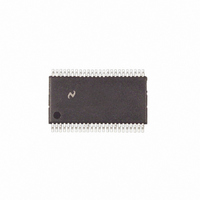COP8SCR9IMT8 National Semiconductor, COP8SCR9IMT8 Datasheet - Page 51

COP8SCR9IMT8
Manufacturer Part Number
COP8SCR9IMT8
Description
IC MCU EEPROM 8BIT 32K 48-TSSOP
Manufacturer
National Semiconductor
Series
COP8™ 8Sr
Datasheet
1.COP8SCR9HVA8NOPB.pdf
(80 pages)
Specifications of COP8SCR9IMT8
Core Processor
COP8
Core Size
8-Bit
Speed
20MHz
Connectivity
Microwire/Plus (SPI), UART/USART
Peripherals
Brown-out Detect/Reset, POR, PWM, WDT
Number Of I /o
39
Program Memory Size
32KB (32K x 8)
Program Memory Type
FLASH
Ram Size
1K x 8
Voltage - Supply (vcc/vdd)
2.7 V ~ 5.5 V
Oscillator Type
Internal
Operating Temperature
-40°C ~ 85°C
Package / Case
48-TSSOP
Lead Free Status / RoHS Status
Contains lead / RoHS non-compliant
Eeprom Size
-
Data Converters
-
Other names
*COP8SCR9IMT8
15.0 Interrupts
15.1 INTRODUCTION
The device supports fourteen vectored interrupts. Interrupt
sources include Timer 1, Timer 2, Timer 3, Timer T0, Port L
Wake-up, Software Trap, MICROWIRE/PLUS, USART and
External Input.
All interrupts force a branch to location 00FF Hex in program
memory. The VIS instruction may be used to vector to the
appropriate service routine from location 00FF Hex.
15.2 MASKABLE INTERRUPTS
All interrupts other than the Software Trap are maskable.
Each maskable interrupt has an associated enable bit and
pending flag bit. The pending bit is set to 1 when the interrupt
condition occurs. The state of the interrupt enable bit, com-
bined with the GIE bit determines whether an active pending
flag actually triggers an interrupt. All of the maskable inter-
rupt pending and enable bits are contained in mapped con-
trol registers, and thus can be controlled by the software.
A maskable interrupt condition triggers an interrupt under the
following conditions:
1. The enable bit associated with that interrupt is set.
2. The GIE bit is set.
3. The device is not processing a non-maskable interrupt.
(If a non-maskable interrupt is being serviced, a
FIGURE 26. Interrupt Block Diagram
51
The Software trap has the highest priority while the default
VIS has the lowest priority.
Each of the 13 maskable inputs has a fixed arbitration rank-
ing and vector.
Figure 26 shows the Interrupt block diagram.
An interrupt is triggered only when all of these conditions are
met at the beginning of an instruction. If different maskable
interrupts meet these conditions simultaneously, the highest-
priority interrupt will be serviced first, and the other pending
interrupts must wait.
Upon Reset, all pending bits, individual enable bits, and the
GIE bit are reset to zero. Thus, a maskable interrupt condi-
tion cannot trigger an interrupt until the program enables it by
setting both the GIE bit and the individual enable bit. When
enabling an interrupt, the user should consider whether or
not a previously activated (set) pending bit should be ac-
knowledged. If, at the time an interrupt is enabled, any
previous occurrences of the interrupt should be ignored, the
associated pending bit must be reset to zero prior to en-
abling the interrupt. Otherwise, the interrupt may be simply
maskable interrupt must wait until that service routine is
completed.)
10138932
www.national.com










